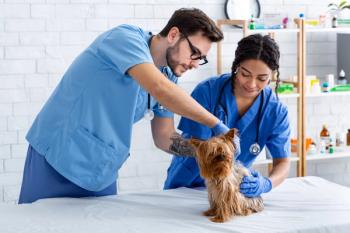
Practical ideas for managing common urologic problems
These tips-two for dogs and one for cats-are easy to implement and will improve patient care.
These suggestions will raise technicians' awareness of common urologic problems or situations in pets and help improve a patient's outcome and minimize complications in daily practice.
(GETTY IMAGES)
Top tips for dogs
In dogs with a recent onset of urinary incontinence, it should be identified whether polyuria and polydipsia are occurring before drug therapy is started. Some clients may not be aware that polyuria and polydipsia can be linked to urinary incontinence, so they may not report the polyuria and polydipsia. Polyuria can overwhelm the capacity of the sphincter in dogs with marginal sphincter function, resulting in urinary incontinence. If the underlying cause of polyuria and polydipsia is corrected, the incontinence usually resolves.
A urine bacterial culture should be done, regardless of urinalysis results, in dogs that present with polyuria and polydipsia, signs of urinary tract disease, or an endocrinopathy. The urinalysis may not show marked signs of inflammation, and bacteria may not be seen, in many disease states. This situation is particularly true with diseases that cause dilute urine production, suppress immune function, or otherwise inhibit the normal urinary tract defense mechanisms, such as diabetes mellitus and hyperadrenocorticism. In addition, occult pyelonephritis may cause polyuria and polydipsia. It's acceptable that a culture not be done in a dog that is experiencing its first episode of lower urinary tract signs consistent with cystitis. But cultures should be done if subsequent episodes occur.
(GETTY IMAGES)
Top tip for cats
A polypropylene urinary catheter should not be left in the urethra of an unblocked male cat. It should be replaced with a polyvinyl or red rubber catheter. Polypropylene (used in tomcat catheters) tends to be irritating to urethral mucosa and can cause urethrospasm once the tube is removed, often resulting in a cycle of recatheterization and additional irritation. Polyvinyl (used in infant feeding tubes) and red rubber catheters are nonreactive. If a polypropylene catheter must be left in, an antispasmodic such as prazosin should be prescribed by the veterinarian from the beginning. All catheters should be attached to a closed, sterile collection system.
Kenneth R. Harkin, DVM, DACVIM, is section head and an associate professor for the department of Small Animal Internal Medicine in the College of Veterinary Medicine at Kansas State University in Manhattan, Kan.
Newsletter
From exam room tips to practice management insights, get trusted veterinary news delivered straight to your inbox—subscribe to dvm360.




